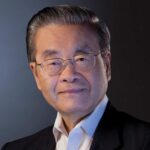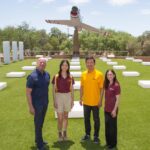
ASU takes lead role in accelerating solar energy advances
Posted: August 17, 2011

Christiana Honsberg, a professor in the School of Electrical, Computer and Energy Engineering, will lead QESST, ASU’s first ERC. “An expanding global economy is bringing an unquenchable demand for more electrical power. It will become vital to progress throughout the 21st century to have the benefits of alternative energy sources that solar power can provide through photovoltaic technologies,” says Honsberg. Photo by: Jessica Slater/ASU
Engineering faculty will direct national research center supported by National Science Foundation and Department of Energy
Arizona State University will lead a new national Engineering Research Center (ERC) supported jointly by the National Science Foundation (NSF) and Department of Energy (DOE) to solve challenges to harnessing solar power in economically viable and sustainable ways.
The ERC for Quantum Energy and Sustainable Solar Technologies – or QESST – will be led by faculty from ASU’s Ira A. Fulton Schools of Engineering.
ASU researchers will work with colleagues at the center’s partner institutions – the California Institute of Technology, Massachusetts Institute of Technology, the University of Delaware and the University of New Mexico – to provide a staging ground for major innovations in solar energy devices and systems.
The NSF and DOE will jointly provide funding of $18.5 million for the first five years of the center’s operations.
The center’s mission includes accelerating commercialization of solar energy technologies through partnerships with industry and expanding opportunities for education in energy engineering.
Engineering Research Centers sponsored by the NSF focus on areas of research considered vital to national interests in science and engineering innovation, technological advancement, economic expansion and education of future innovation leaders.
Selection as a lead institution for one of these centers reflects exceptional regard for the expertise of a university’s faculty in such important areas of research.
QESST will be directed by Christiana Honsberg, a professor in ASU’s School of Electrical, Computer and Energy Engineering.
“An expanding global economy is bringing an unquenchable demand for more electrical power. It will become vital to progress throughout the 21st century to have the benefits of alternative energy sources that solar power can provide through photovoltaic technologies,” said Honsberg, who also directs ASU’s Solar Power Lab.
Collaboration between ASU and partner universities will be coordinated by Harry Atwater, a professor of applied physics at Caltech, who will serve as QESST’s research director.
ASU electrical engineering professor Sayfe Kiaei, former associate dean of research for the Ira A. Fulton Schools of Engineering, will be QESST’s testbed leader, responsible for developing platforms for evaluating and testing new technologies. Matthew Fraser, an associate professor in ASU’s School of Sustainability, will be sustainability director.
Beyond enabling collaborations among university research teams, the center will bring universities, major energy companies, photovoltaics industry leaders and entrepreneurs together in partnerships.
“All members of the QESST leadership team have experience in industry, with start-up companies and with technology transfer from the lab to the marketplace,” Honsberg said.
More than 40 companies have committed support for QESST, including major manufactures and companies that produce basic materials, photovoltaic devices and systems, and provide installation of solar energy technology.
The center’s efforts will also benefit from ongoing energy research and education collaborations with affiliate partners, including Georgia Tech, the University of Arizona, the University of Houston and the National Renewable Energy Laboratory, and international members, including the University of Tokyo, Imperial College London, and the University of New South Wales.
In addition, QESST will leverage the expertise of other ASU research strengths in centers pursuing advances in power systems and related energy fields. Those include the Power Systems Engineering Research Center (PSERC), the Sensor, Signal and Information Processing center (SENSip) and Connection One, a wireless communications center – each of which is an NSF Industry/University Cooperative Research Center.
QESTT will also partner with the Future Renewable Electric Energy Delivery and Management (FREEDM) Systems center, an NSF Engineering Research Center led by North Carolina State University, in which ASU is a partner institution.
Along with pursuing advances to increase the efficiency of photovoltaic devices for converting sunlight into electrical energy, researchers will develop new manufacturing processes to produce photovoltaic solar power systems at an unprecedented scale that can be integrated into the nation’s power grid for widespread energy distribution.
The center’s research and development advances will enable the photovoltaics industry to reach production levels sufficient to provide global-scale manufacturing of photovoltaic devices and systems.
The overriding goal of the endeavor is to enable photovoltaic technologies to be capable of supplying a majority of new electricity generation in the United States within a decade, as well as providing power for up to 1.5 billion people worldwide who now have little or no access to electrical energy.
The distinctive factor in the QESST endeavor will be in applying one of the greatest scientific advances of the 20th century – quantum mechanics – to development of advanced photovoltaic technologies .
Quantum mechanics has revolutionized integrated electrical circuits that power computers and communications, enabling devices to be made smaller, more efficient and multi-functional. Ten years ago, cell phones made and received calls. Today, they take photos, surf the Internet and make automated payments.
QESST researchers will apply the same principles of quantum mechanics to developing energy generation systems that convert sunlight to energy more efficiently, and to the design of energy systems that can be integrated into homes and offices while also cleaning the atmosphere. Through this approach, QESST will seek to fundamentally alter how energy is used in the future, Honsberg says.
The key will be making innovations to photovoltaic systems while keeping costs at sustainable levels, she says.
A major impact of successfully developing the technologies to achieve that goal, Kiaei says, will be expanding opportunities for U.S.-based businesses to capture a large portion of the estimated future trillion-dollar global energy industry.
More widespread use of solar power also provides environmental benefits by reducing the need to burn fossil fuels for energy. More efficient manufacturing processes and more energy-efficient, high-performance photovoltaic devices and systems will also enable the country to better conserve natural resources, Honsberg says.
The center will assemble industry and science advisory boards, as well as an entrepreneurship investment council.
The boards will provide guidance in areas such as research performance, progress evaluation, commercialization strategies, and opportunities for new research and industry collaborations, and other funding sources.
The council will seek support from investors to help market new technologies and intellectual properties generated by QESST, and advise the center’s leaders about new entrepreneurship possibilities.
A strong component of the center’s mission is to improve engineering education and expand the community that is engaged in energy research and education. This will entail developing research opportunities for undergraduates and teachers, research leadership roles for graduate students, programs to motivate middle school and high school students to study engineering and science, and enable them to participate in engineering research projects.
“QESST will provide students of all ages opportunities to be part of the future of solar energy engineering,” says Jenefer Husman, the center’s education director and an associate professor in ASU’s School of Social and Family Dynamics. “ASU and our partner institutions will help produce the next generation of sustainability-focused solar engineers.”
More information about QESST is posted on the center’s website at www.qesst.org and on an NSF website athttp://www.nsf.gov/news/news_summ.jsp?cntn_id=121039&org=ENG&from=news
For more about the scope of solar-energy related research by Ira A. Fulton Schools of Engineering faculty, see “ASU engineers poised for progress in solar power quest.”


































